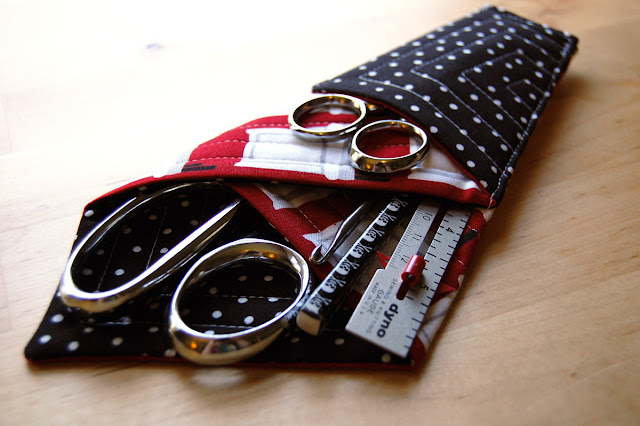Mending Day
I get a small pile of mending to do every few months. Today I'm mending a small hole in my hub's jeans. He seems to always get these stress rips from the pocket where he keeps his wallet. Here's a simple way to mend small rips and holes in jeans to give them some extra life.
I learned some of these tips from my co-worker Jaime, you can read her comprehensive tutorial for mending jeans here at WeAllSew.
To mend a hole in jeans you'll need a few simple tools. Scissors, thread snips, a darning foot, a bit of extra denim for a patch, and a small piece of iron on interfacing.
Because this little rip is right under the corner seam of the pocket, I'm using a seam ripper to remove the corner. This will make for a stronger repair, and I'll stitch the pocket back on at the last step. I've pinned the pocket corner down to keep it out of the way to patch the hole.
I work to apply a patch on the wrong side of the jeans. Cut a small piece of denim that is twice the size of the hole, and apply the iron on interfacing to the wrong side. The interfacing will help stabilize the patch through the stitching process.
Place the patch directly over the hole. I've used temporary spray adhesive to hold the patch in place, but you can also pin the patch from the right side of the jeans.
To use this technique, you'll need to lower the feed dogs on your sewing machine. Most machines will have a button or lever that allows you to lower the feed dogs below the stitch plate to enable free motion stitching. Check your user's manual if you're not sure how to lower the feed dogs on your sewing machine.
To begin, start stitching and moving the fabric back and forth under the needle. Check the video below to see how I'm working the fabric under the needle to make a strong mend in the jeans.
When you've added stitching over the hole, remove the jeans and cut the extra fabric around the patch close to the stitching.
I usually add a few more stitches around the outside edge of the patch to keep the edges secure. Then it's time to sew the pocket back down.
I thread the sewing machine up with matching jeans topstitching thread, leaving the all-purpose thread still in the bobbin. I switch out the foot to the Reverse pattern foot #1D and use with the Dual Feed feature. After making a few test stitches on scrap denim, I match the stitching to secure the pocket. Close to the top of the pocket is a very thick seam. I use the "hump jumper" or Height Compensation Tool that came with my BERNINA 570 QE sewing machine. It's a fabulous tool for helping you to sew over thick seams or bumps!
The tool has three leaves, and you can use them to stack to find the perfect height. The goal when using this tool is to keep the presser foot as level as possible when sewing over a hump, bump, or thick seam.
When the foot is level, it will sew easily over any bumps!
Mending complete! It's not perfect, but now the life of these jeans has been extended. I hope you've picked up a tip or two from these tips!

















Comments